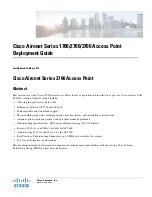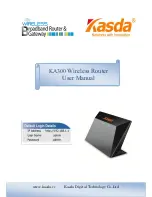
1
Cisco Aironet Series 1700/2700/3700 Access Point Deployment Guide
Cisco Aironet Series 3700 Access Point
Figure 16
Optional AIR-AP-BRACKET-3 Used to Install the AP Directly Into the Tile
Note
This bracket will fit the 1040, 1140, 1260, 1600, 2600, 2700, 3500, 3600, and 3700 series APs.
Wall Mounting the AP
When wall mounting is desired, the installer should understand that walls can be a physical obstacle to the wireless signal;
therefore, maintaining 360 degree coverage may be compromised by the wall. If the wall is an outside wall and/or the goal is
to send the signal in a 180-degree pattern instead, a directional antenna often referred to as a “patch” antenna may be a better
choice assuming that the AP 3600e is used.
Avoid wall-mounting APs with internal antennas, such as the AP 3600i, unless you use the optional Oberon right-angle mount
(
Figure 17
). The internal antenna model was designed to mount to a ceiling to provide 360-degree coverage. If wall-mounted
in a non-ceiling orientation, the signal may penetrate the floor above and below causing unintended coverage that could result
in additional and needless roaming access when a mobility client, e.g., a user with Wi-Fi phone, walks by on an adjacent floor.
Instead, use the AP 3600e (with dipoles or patch antennas) or use an optional wall mount that puts the AP 3600i or AP 3500e
into a ceiling type orientation when mounted to a wall.
Note
APs with internal antennas such as the AP 3600i and AP 3700i that are wall mounted should use the
Oberon mounting bracket unless roaming is not an issue, for example, hotspot, kiosk, or small venue
scenario.













































